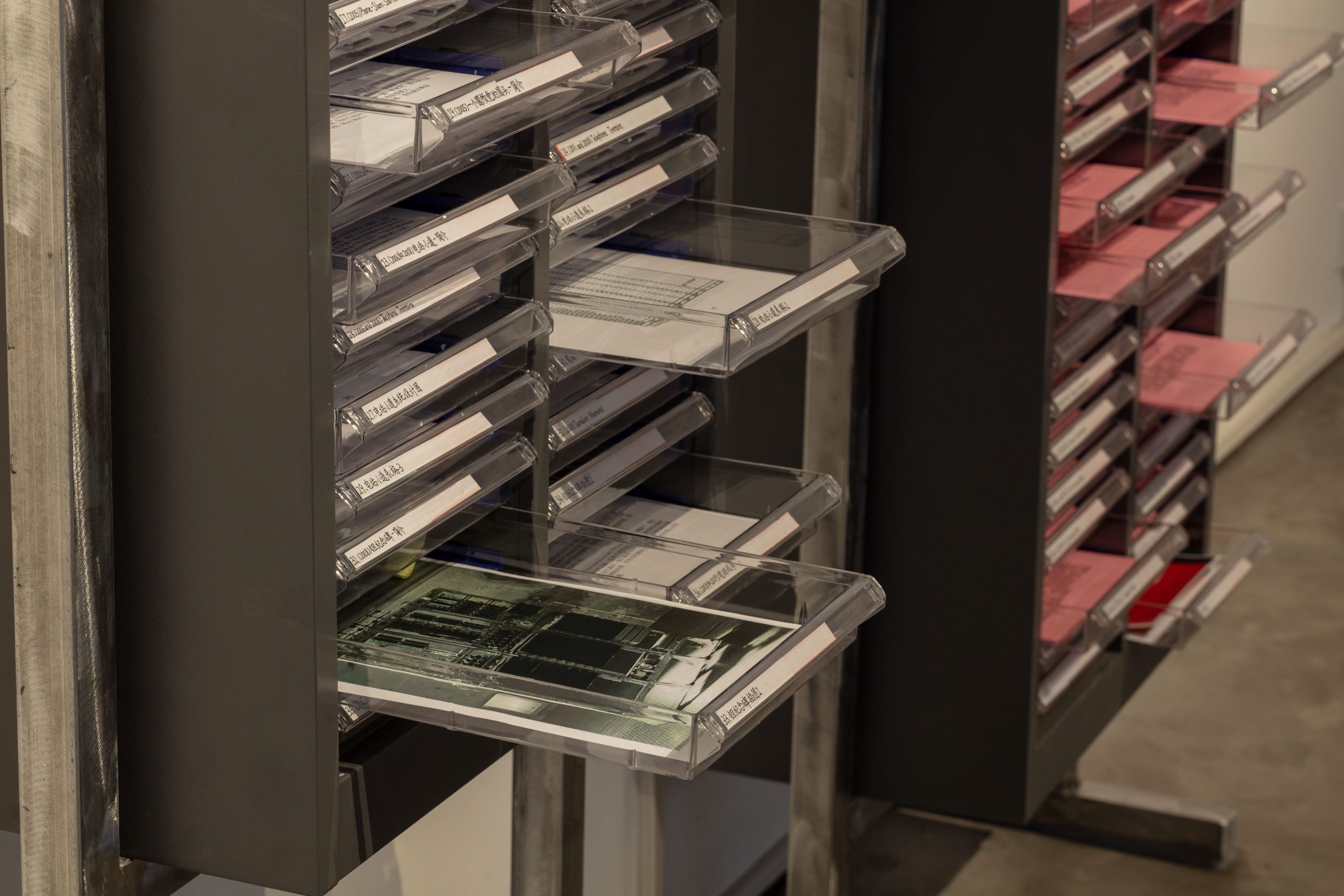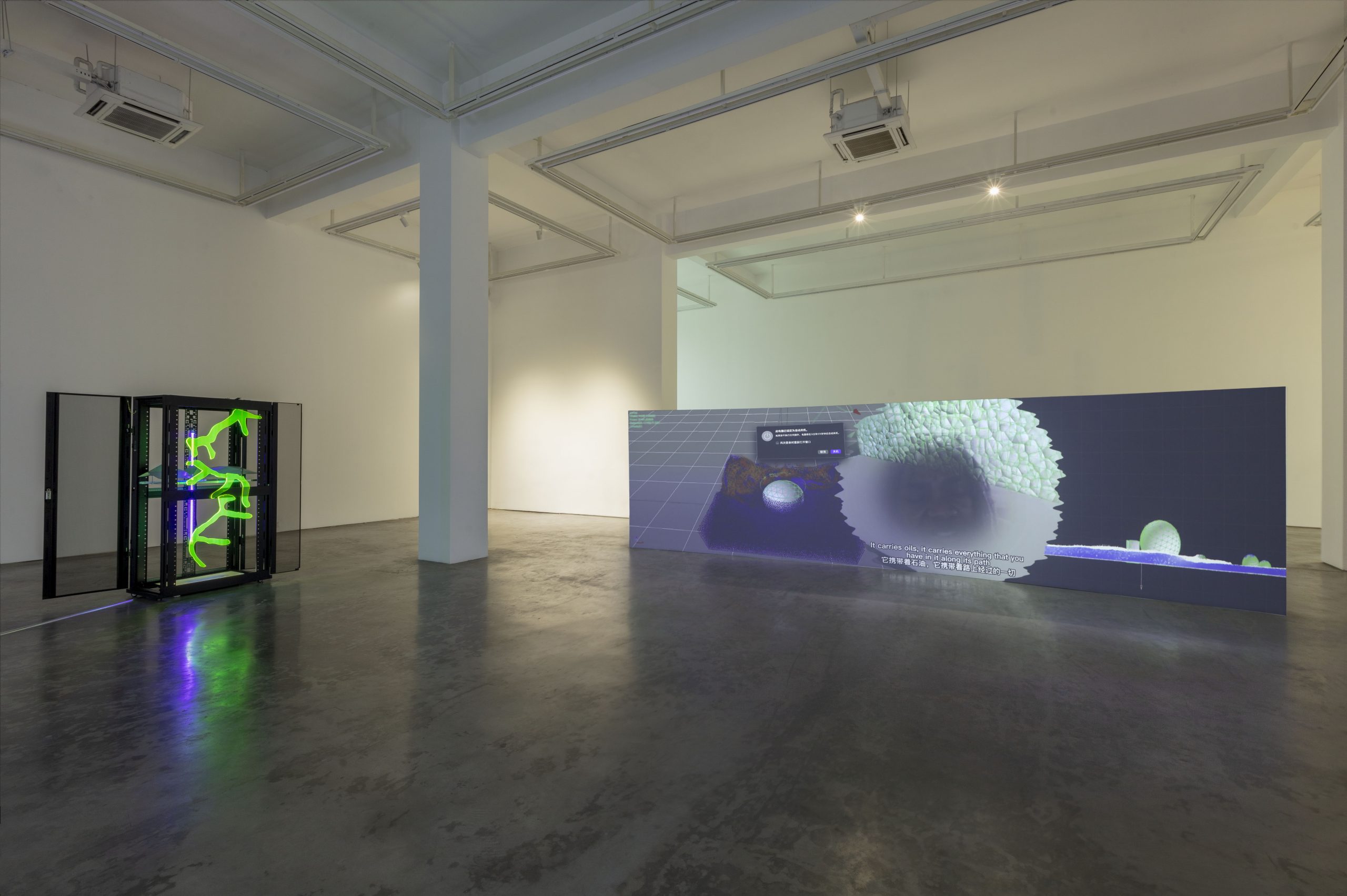Fictions of Inter-domain Routing
山海运算,域间路由
22 APR 2023 - 23 JUL 2023
策展人 CURATORS
迈克尔·康纳(Michael Connor)/ 龙星如 Iris LONG/武子杨 Ziyang WU

当你刷手机查看这条消息的时候,会发生什么?在你来长征空间看展的路上,使用地图导航时, 触发了什么?在与手机、电脑、自动驾驶汽车和智能系统互动的每个时刻,我们都被卷入了一个巨大、广泛而错综复杂的全球基础设施网络中。在变为可读信息之前,这些信号会跨越山海,在天空和海洋之间通过海底电缆和“星链”等基于卫星的网络进行计算。 在展览“山海运算,域间路由”中,艺术家们的作品以历史研究、故事讲述、社会实践、雕塑、 电子游戏,以及另类介入信息系统行为等方式,以诗意和批判的角度,探索真实和虚构的通信网 络和基础设施,包括我们与这些技术系统的种种纠葛。 除了质疑和探讨现有的基础设施网络(也是本杰明·布拉顿“堆栈” 1的一层),艺术家们探讨的是挖掘那些挑战主流范式的可供选择性网络的潜力。这些可供选择性网络提供了除互联网和全球 通信系统霸权结构之外的连接、沟通和协作的模式。“它们是物体,也是物体之间的关系。” 2布莱恩·拉金(Brian Larkin)对基础设施特殊的本体论 的描述适用于行星计算概念中的基础架构层:它不仅是一个技术装置,还是一个争夺资源、并将劳动遮蔽的场所,其间充满了斗争、数字殖民主义以及不可分割的权力。以全球范围来看,这些艺术家具体研究的案例出现在一些所谓的中间地带,比如基础设施建设中对矿物的采掘通常穿越 不同的地理/地质区域,基础设施也成为私有和垄断的必争之地;同时,通过基础设施展开的治 理是在物理和虚拟(协议)层面上同时开展的,而谈判通常发生在那些看似地理上最偏远和人口最稀少的地方。 在计算机科学中,“跨域路由”指的是路由算法在域内和域间的工作协议。我们提出将“跨域路由”作为探索和栖居于网络基础设施的方法。我们构想“域”不仅是“领土”的实际或虚拟的对应物,而且还是知识和实践的维度。艺术实践中的跨域“路由”不仅在技术领域发生,还涉及时间、文化与生态。它是对多种力量和时空配置比例的引入,其中一些是碎片化的,一些是“丰碑 式的”——用基础设施研究者英格丽德·伯林顿(Ingrid Burrington)的话来说,一些是有形的, 一些是不可见的。“路由”可以是出人意料的、严苛的或者具有表演性的——但更可以成为生存的手段。

本次展览邀请了 7 位/组国内外艺术家参与,大多作品在国内第一次展出。作品从不同的时空坐 标出发,探讨了历史的、当下的以及推演的“跨域路由”形式。在电子干扰剧场 2.0/b.a.n.g.实验 室的作品《水源与诗——边境生存指南》(2007–至今)和塔比塔·雷扎尔的作品《潮汐深处》(2017) 中,沙漠成为了一条秘密的交通网络,而海洋可以是关于通讯和记忆的传导界面。这两件作品创 造了一种平行叙事,亦即,跨域的身体如何通过大陆与国家之间的技术网络得以穿行、游走。这 些作品实际上也通过“导航”这个行为揭示了一些隐藏的历史;在《水源与诗——边境生存指南》 中,美国和墨西哥边境沙漠中的水源位置和跨域道路成为了作品诗歌的源头;在《潮汐深处》中, 海底光缆揭露了殖民史上奴隶船的跨洲路径。这两件作品同时也通过提出另类的技术模型,来反思技术系统中的暴力。
《水源与诗——边境生存指南》是一个手机应用程序,同时也是一种求生技术和一个诗意的界面,那些跨越美墨边境的人们可以使用它来寻找水源。这件作品的技术可以为跨越边境的人群提供实际的支持和有用的信息(理论上,它可以被拓展和应用到所有的跨国边境地带),而不是继续固化当下技术不平等的局面。《潮汐深处》则将海洋及水体本身想象成一种通讯网络和存储媒介,并通过这种想象来诠释并质疑跨大西洋奴隶贸易的遗留问题和“数字殖 民主义”的现实。通过将我们与海洋潮汐的节奏联系起来,作品邀请我们想象一个与自然界更深地融为一体的未来。 以艺术家的视角来看,基础设施不仅仅在物质上是厚重的,也可能是微妙的,甚至是带着纪念色彩的。丽莎·帕克斯(Lisa Parks),葛拉罕·皮克仁(Graham Pickren)和胡彤晖等学者都曾追溯 过“云”的“代际更替”,诠释了“云”这样一个抽象的意向是如何从更古老的网络技术、政治、工业模型中生长出来的:“云”的前身可能是一座军事掩体、一间饼干厂抑或一间报纸印刷厂。基础设施的物质性上的延续特点也提供了一种时间上的“跨域”可能:哈伍德、莱特、横小 路的作品《钽纪念碑》(2008–2009)最早是一系列基于电话网络的装置,以纪念与缅怀自 1998 年以来,在刚果发生的战争(也被称为“钶钽铁矿石战争”)中丧生的 400 多万人。作品复原并重新激活了一台古老的电话交换机,并让它连接到一个定制化的网络中,这个名为“电话小道”(Telephone Trottoire)的网络是专门为刚果难民发明的,致敬了刚果难民群体广泛使用的“街头无线电”(pavement radio)系统。艺术家团队通过装置、 出版等一系列的创作,提出了关于我们对技术的依赖、以及技术生产对社区和环境的影响等问题。

丹尼斯·德·贝尔长达一年的研究项目《山中要塞》(2022)则以法证研究的方式绘制了一套遍及全球的数据中心地图,这些数据中心大都对现有的基础结构进行了再利用:如冷战掩体、自然洞穴、矿井甚至是宗教建筑。这两件作品都通过潜入基础设施的同质化表面,并建立时间上的非线性联系,将缄默的、被忽视的和被刻意忽略的东西交织在一起。武子杨的作品《巴石河 2030 – 6 Plus》(2022)和武子杨与马克·拉莫斯共同创作的《未来_预报》 (2021–至今)深入探讨了“数字地球”计划、“一带一路”合作倡议和菲律宾的“大建特建” 规划背景下的各类情况。这两件作品虚构了一个背景,并试图提问:即将在未来成立的一家互联网服务供应商和区块链公司将会对一条河流、一个当地家庭或一英亩的土地产生什么样的影响?该作品以菲律宾这一“超级堆栈”平台尚未实现的发展中地区作为研究和虚构的对象,提供了另一种建构世界的实验田——通过一个网络游戏邀请所有观众参与集体构建游戏的内部社会景观,去探讨资源、劳动力、基础设施建设、技术使用、地区经济和最重要的日常生活之间错综复杂的超链接关系。 此外,耶伦·范·洛恩的作品《转瞬即逝的数据-中国版》(2023)对延伸到海床的海底电缆进行了诗意性的考察和表演性的反思和重绘,展览中将呈现的是艺术家基于此次展示地点创作的全新版本,其中引入了连接中国和东南亚、南亚、非洲、大洋洲、欧洲和北美的海底电缆的地理数据,然后用代表数字基础设施中光缆原材料的细沙呈现曼陀罗沙画。该作品还为展览增加了一个时间维度:曼陀罗沙画将每天由表演者逐渐地向上叠加,直到展览闭幕那天。这个渐进的过程也用可视的方式呈现我们的数字文化中发生的积累与转变。

“山海运算,域间路由”在展览期间也将进行公开征集,对展览探讨的问题进行延伸,反思地缘政治的基础设施配置,如数字一带一路等。这个公开征集计划邀请艺术家、设计师、研究者和技术专家通过电子邮件提交一页提案,提出尚未存在但有机会实现的有关跨国数字网络的想法,自由地来讨论基础设施能够成为、以及能够做什么,并反思虚拟与现实中的跨国路线的概念,以及站在我们所处位置来看,它究竟意味着什么。这些提案可能包括操作说明、代码、诗歌、摄影、 视频以及3D打印,并将在中国本地被实现。


What happens when you swipe your phone and check this message? W
In this exhibition, artists offer poetic and critical interfaces to communications networks and infrastructure both real and imagined. They allow us to explore our entanglement in these technical systems through works that draw on historical research, social practice, hacking, storytelling, videogames, and sculptural uses of technology. As well as interrogating and problematizing the existing Stack[1], several of the artists consider the potential of alternative networks that challenge the dominant paradigm. These alternative networks offer modes of connection, communication, and solidarity, beyond the hegemonic structures of the Internet and global communication systems. “They are things and also the relation between things.” Brian Larkin’s[2] description of the peculiar ontology of infrastructures applies to the infra layer of planetary computation: not only a technical assemblage, but also a contested field of resource excavation, obscure labor, digital colonialism, inseparable power, and struggles. Abstract on a global level, the cases these artists examine concretize at in-between spaces where minerals traverse geographical and geological zones, infrastructural privatization and monopolization interlock, governance takes shape physically and virtually, and territorial negotiations form at those seemingly geographically most remote and sparsely populated sites.
In computer science, “interdomain routing” refers to the protocol in which the routing algorithm works both within and between domains. We propose “interdomain routing” as a method of exploring and inhabiting the stack of infrastructures. We envision a domain not only as an actual and/or virtual counterpart of “territory,” but also as a sphere of knowledge and practice. Interdomain routing as an artistic practice involves “routing” not only technological domains but also temporal, ecological, and cultural ones. It can involve traversing multiple scales of force and spacetime configurations, some of them fragmented, some “monumental” (in Ingrid Burrington’s words), some tangible, some invisible. Routing can be unexpected, performative, hypercritical; it can even be a means of survival.

Exploring historical, current, or speculative interdomain routing, the artworks are each situated at a different point on the temporal and spatial axes. A desert is a secret transportation network. An ocean can be a conductive interface for communication and memory. Electronic Disturbance Theater 2.0/b.a.n.g. lab’s work Transborder Immigrant Tool or TBT (2007 – ongoing) and Tabita Rezaire’s Deep Down Tidal (2017) create a parallel narrative about how “transnational” bodies are conducted by networks across continents and countries. The works reveal hidden histories through navigation: in TBT the locations of water supplies and pathways through the desert form the basis of poems, and in Deep Down Tidal, underwater cables are revealed as the modern traces of the routes taken by slave ships. They also both explore technological violence, while offering alternative models. TBT is a mobile phone application that is both a life-saving technology and a poetic interface intended to guide individuals who were making their way to the United States through the deserts of the U.S./Mexico borderlands. The work (which theoretically could be expanded to cross all kinds of borders) uses technology to provide practical support and information on behalf of marginalized communities, rather than perpetuating existing systems of inequality. Deep Down Tidal proposes the ocean and water itself as a communications network and storage medium through which to understand and contest the legacy of the Transatlantic slave trade and the realities of “electronic colonialism.” By connecting us to the rhythms and cycles of the ocean, Deep Down Tidal invites us to imagine a future where we are more deeply in tune with the natural world. Infrastructuring is heavily material, and in the artists’ perspectives, subtly memorial.
Lisa Parks, Graham Pickren, Tung-hui Hu and many scholars have traced the genealogies of the cloud and how it grew out of older network technologies, politics, industrial models, and other types of precedents: a military bunker, a biscuit factory, or a newspaper printing house. This particular material inheritance also hints at the possibility of routing across time: Harwood, Wright, Yokokoji’s work Tantalum Memorial (2008) is originally a series of telephony-based memorials to the more than 4 million people who have perished in the complex wars that have gone on in the Congo since 1998 (often referred to as the “Coltan War”). The physical historical telephony switch is resurrected and reactivated to re-enter a customized network attributing to Congolese practice of “Telephone Trottoire.” Through a series of works ranging from installations to publications, Harwood, Wright, Yokokoji raises questions about the ethics of our reliance on technology and the impact of its production on communities and the environment.


Dennis de Bel’s year-long research, Mountain Stronghold (2022), meanwhile, forensically maps data centers that re-use existing infrastructures such as cold war bunkers, natural caves, mines and religious structures worldwide. Both works interweave the mutPasig River 2030 – 6 Plus (2022) and Ziyang Wu & Mark Ramos’s Future_Forecast (2021 – ongoing), meanwhile, specifically investigate the context of “Digital Earth”, “One Belt One Road Initiative” and the “Build Build Build Initiative” in the Philippines. These works ask, what will a speculative future ISP and blockchain company do to a river, a local family, and an acre of land? By opening up the collective building option to all audiences, the work invites people to investigate the intricate and hyperlinked relationship among resources, labor, infrastructural construction, technological utilization, regional economy and most importantly, everyday life. The quasi-state of infrastructuring in the speculative, simulated Philippines is a test-field for alternative worlding. Furthermore, Jeroen van Loon’s work Ephemeral Data, is a poetic investigation and performative reflection and remapping of the undersea cables that stretch across the ocean floor. In this exhibition, the artist creates a site-specific version of the piece which incorporates geo-data of submarine cables connecting China and South East & South Asia, Africa, Oceania, Europe and North America. Ephemeral sand, also the raw material of fiber optic cables, is transformed into mandala paintings representing our digital infrastructures. The piece also adds a temporal layer to the show: the mandala will be created by performers inch by inch on a daily basis till the closing day, a gradual process visualizing the accumulation and shifts taking place in our digital culture.
The open call section of the exhibition, following this trajectory and reflecting on the geopolitical infrastructural configurations such as the digital belt and road, invites artists, designers, researchers and technologists to submit a one-page proposal via email with ideas about non-existing and to-exist transnational digital networks, illustrate freely how infrastructures can be and what they can do, and reflect on the idea of a virtual and physical transnational route and what it means from a situated perspective. All proposals, ranging from instruction, code, poetry, to photography, video and 3D printing, will be materialized and produced in China.
1 The Stack is an interdisciplinary design brief for a new geopolitics that works with and for planetary-scale computation. Bratton, B.H. (2016) The Stack: On software and Sovereignty, MIT Press. Available at: https://direct.mit.edu/books/book/3504/The-StackOn-Software-and-Sovereignty (Accessed: April 2, 2023).
2 Brian Larkin (2013) The Politics and Poetics of Infrastructure, Annual Review of Anthropology, 42, 327-343, Available at: https://doi.org/10.1146/annurev-anthro-092412-155522.